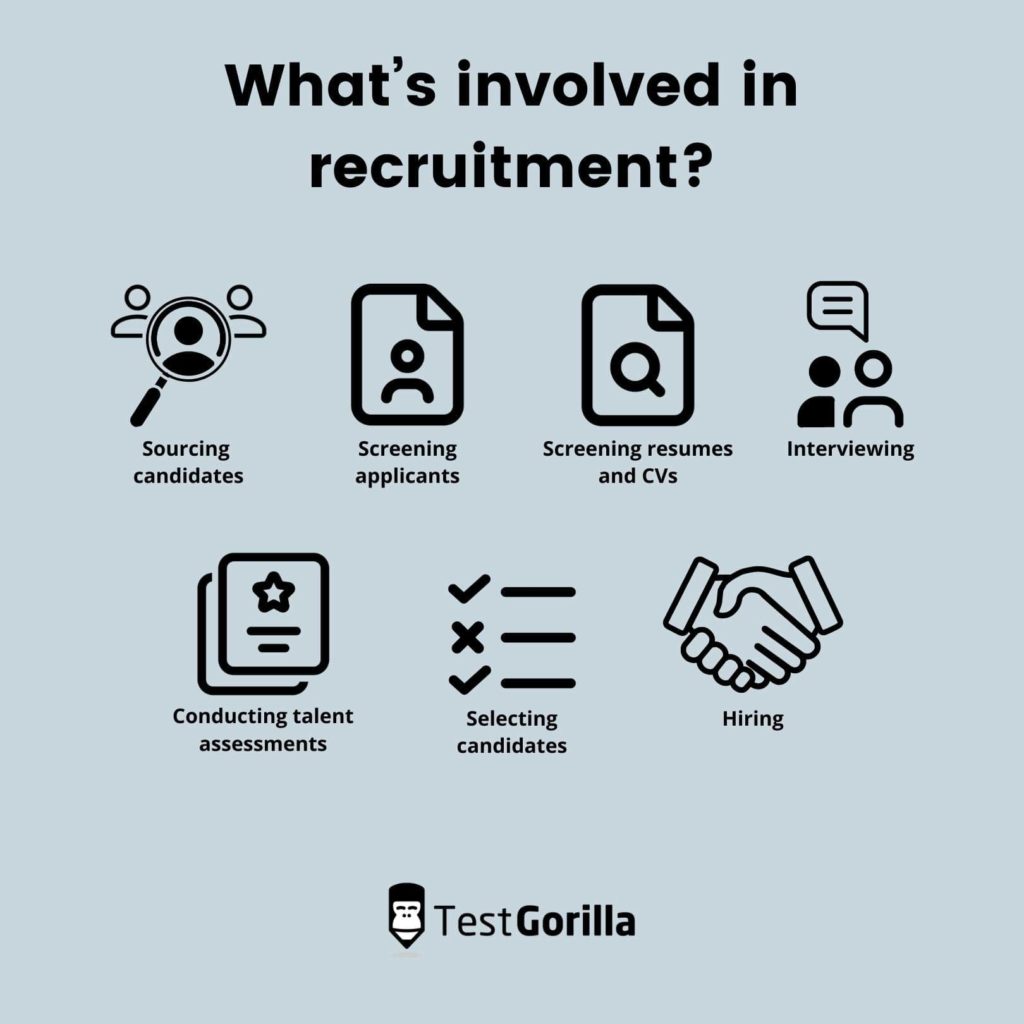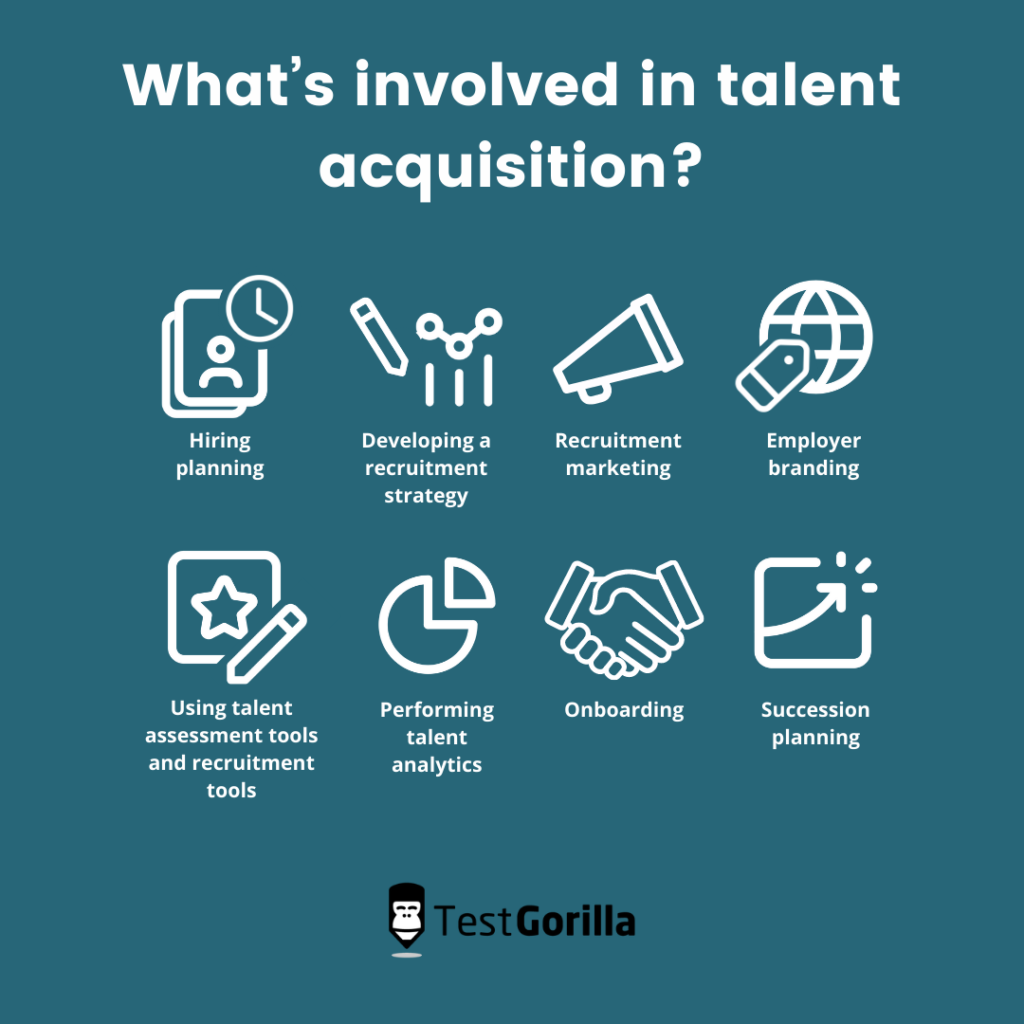Talent acquisition is more than a fancy word for recruitment.
Knowing the distinction between these two concepts and strategies is critical to bringing in better and more productive talent to your organization.
This article will discuss the main differences between recruitment and talent acquisition and why talent acquisition should be your top priority.
We’ll also provide helpful tips for putting a talent acquisition strategy into action.
Talent acquisition vs. recruitment: What’s the difference?
Talent acquisition is a strategy. It focuses on how a company intends to position itself as an attractive destination for top talent and how it plans to source, assess, employ, and onboard that talent.
Recruitment is an action. It’s the collection of tactics required to fill available job vacancies, including sourcing, screening, interviewing, assessing, selecting, and hiring candidates.
Recruitment is, therefore, a subset of a holistic talent acquisition strategy.
What’s involved in recruitment?
Recruitment involves all the traditional hiring activities needed to fill vacant positions, including:
Conducting talent assessments
As a result, a recruiter spends most of their time reaching out to and interacting with candidates and assessing their fit for a particular role.
What’s involved in talent acquisition?
Talent acquisition is a more modern, strategic approach to hiring. In addition to traditional recruitment activities, talent acquisition also includes:
Developing a recruitment strategy
Using talent assessment tools and recruitment tools
Performing talent analytics
While the scope of talent acquisition is broad, it excludes other HR responsibilities such as promotions, retention, coaching and development, conflict resolution, workplace incidents, etc.
As a result, talent acquisition managers and specialists spend most of their time developing recruitment and employer branding strategies—though most will also assist with recruiting operations.
Why you should prioritize talent acquisition over recruitment
Pitting talent acquisition and recruitment against one another is misleading because recruitment is a component of talent acquisition. However, it’s important not to take a recruitment-only approach to hiring.
If you focus only on recruitment, your hiring will always be reactive. Talent acquisition enables you to be proactive about your future hiring needs.
Talent acquisition is essential in the following situations:
Fast-growing companies: Companies that grow quickly without a solid hiring strategy risk hiring the wrong people or losing their culture.
Competitive industries: If candidates in your industry are in high demand, you’ll need a strategy to stand out from your competitors.
Attracting niche talent: In specialized industries such as technology, finance, legal, or medicine, you’ll need a plan for identifying candidates with the right skills.
Hiring leadership: Succession planning is necessary for key leadership positions—especially if you’re in a complex industry.
Regardless of your industry, implementing a comprehensive talent acquisition strategy comes with many benefits:
Grow your candidate pool: A talent acquisition strategy allows you to grow and nurture your candidate pool, creating a greater number of candidates to choose from when the time comes to hire.
Hire more culture adds: You can be more intentional in hiring for culture add if you know your existing teams and have a well-thought-out plan for corporate culture.
Faster time-to-hire: When you’re ready to hire, a proactive strategy makes it simpler to find the right people for your vacant position.
Make better hiring decisions: Speed isn’t everything. A talent acquisition strategy also guarantees that you hire the appropriate individuals for the right jobs.
The best insights on HR and recruitment, delivered to your inbox.
Biweekly updates. No spam. Unsubscribe any time.
How to create a talent acquisition strategy
Here’s how to move past short-term-focused recruitment with an end-to-end talent acquisition strategy.
1. Clarify your business goals
Because talent acquisition is about taking a strategic, long-term approach to hiring, a sound talent acquisition strategy starts with understanding your long-term company objectives.
What are the company’s long-term objectives over the next one to five years? What areas of the business are most likely to grow? What type of organization do you want to become?
For example, if your company wants to ramp up its revenue quickly, you may need to hire more sales and marketing team members. If you’re going to launch a new product, you may need to hire additional developers or engineers.
If your company plans to expand into a new geographical market, you should plan to hire candidates who live in that market or have international business experience. In this case, you’d need to collaborate with HR and Legal to verify that your company is prepared for any local hiring regulations within that market.
Whatever the situation may be, you won’t be able to make an informed decision about what jobs to fill unless you understand your company’s long-term prospects.
Ensure your talent acquisition team is aligned with your company’s senior leadership on what’s coming next.
2. Create success profiles
Business goals in hand; you can conduct a workforce analysis to determine which positions are most critical to the success of your organization.
Then, for each open position, you should create a success profile. This written document identifies the talent acquisition skills, competencies, traits, and experiences an employee needs to succeed in that role.
Consider the following for each position:
Hard skills, such as programming or accounting
Soft skills, such as leadership or time management
Culture-add traits, such as values, behaviors, and interests
For example; if you’re a startup, you will need all of your employees to be resilient, adaptable, and excited by change.
3. Craft an employer brand
Just like a company needs corporate branding to attract customers, companies need strong employer branding to attract job candidates.
According to a study conducted by LinkedIn in 2012, a strong employer brand is twice as likely to be associated with job consideration as a solid corporate brand.
Employer branding is all about showcasing your organization as a positive place to work. This includes:
Communicating your company mission
Sharing your company values
Highlighting key team members
Showcasing culture initiatives
Giving evidence of work-life balance
Managing and engaging with online reviews
Here’s an employer branding fact: it’s extremely hard to fake.
It all begins with strong company culture. If that’s in place, sharing it with others outside of your organization is a matter of sharing it.
Your website, social media profiles, job portals, and anywhere else your potential candidates hang out online should prominently feature your employer brand.
4. Diversify your outreach and sourcing strategies
Relying on a single recruitment channel isn’t only risky and ineffective at attracting a diverse range of talent.
While marketers and salespeople may be easily accessible on LinkedIn, software developers, for example, may be more difficult to contact. In that situation, Reddit, GitHub, Stack Overflow, and Twitter may be better places to look for talent.
In addition to a range of online channels, try offline channels as well. For example, you could host networking events, career fairs, or other professional events to broaden your candidate pool.
Diversifying your sourcing channels is also necessary for hiring more diverse candidates. Many companies claim a lack of a diverse candidate pool justifies not having more team diversity. This is because sticking to the recruitment channels you are familiar with will mean hiring candidates similar to your existing team.
Proactively seek out channels that showcase historically marginalized or underrepresented groups regularly. For example, straight white males are often overrepresented in tech roles. To diversify your candidate pool, you could seek out candidates in communities such as Women Who Code, Black Girls Code, Lesbians Who Tech, etc.
The beauty of the internet is that niche groups exist like this for nearly every industry.
5. Target passive candidates
The best candidates for your open roles are most likely already employed elsewhere.
Passive recruitment aims to attract candidates who aren’t actively looking for a new job but would be interested in working for you.
Passive recruitment has many advantages:
Passive candidates are unlikely to be looking for roles elsewhere
Passive candidates are more likely to underestimate their skill sets
Passive candidates are more likely to have the right experience match
So, how can you attract passive candidates?
Networking: Ask your network for referrals.
Employer branding: Recruitment marketing may catch the eye of passive candidates.
Tailored outreach messages: Craft outreach messages unique to the candidate, as they may require more convincing than a candidate actively searching for a job opportunity.
Recommended reading: How to source, engage, and convert passive candidates in one workflow.
6. Establish unbiased hiring practices
Even the most well-intentioned recruiters may exhibit unconscious bias.
For example, The American Economic Association conducted a study that showed job applications with ‘white-sounding names were twic0e as likely to receive callbacks than ‘black-sounding’ or ‘Asian-sounding’ names.
Unfortunately, not all biases are this obvious. Interviewer bias can be as simple as giving more value to the most recent applicants you interviewed or rating a candidate based solely on the first impression you received from the first five minutes of an interview.
A proper talent acquisition strategy mitigates bias by
Educating hiring teams on bias
Clearly defining a role’s success profiles
Hiring for culture add rather than culture fit
Anonymizing resumes
Screening with pre-employment assessments
Pre-structuring interviews
7. Screen candidates with pre-employment assessments
In isolation, resume screening has major limitations. Screening tools can be too aggressive with keyword requirements, resulting in managers easily overlooking top candidates or red flags, and resumes can’t adequately reflect a candidate’s skills.
Therefore, pre-employment assessments are a better alternative to resume screening.
Using TestGorilla, you can screen candidates using carefully selected and scientifically supported screening tests that evaluate candidates based on their actual skills and capabilities rather than what’s stated on their resume.
For example, you can test candidates on their:
Other role-specific skills
These tests provide you with a thorough picture of the candidate while avoiding recruiter bias. They also improve the candidate experience by demonstrating your commitment to hiring the right people.
Ready to jumpstart your talent acquisition strategy?
To get started with TestGorilla today, request a demo or create a free account today.
Related posts
You've scrolled this far
Why not try TestGorilla for free, and see what happens when you put skills first.





















